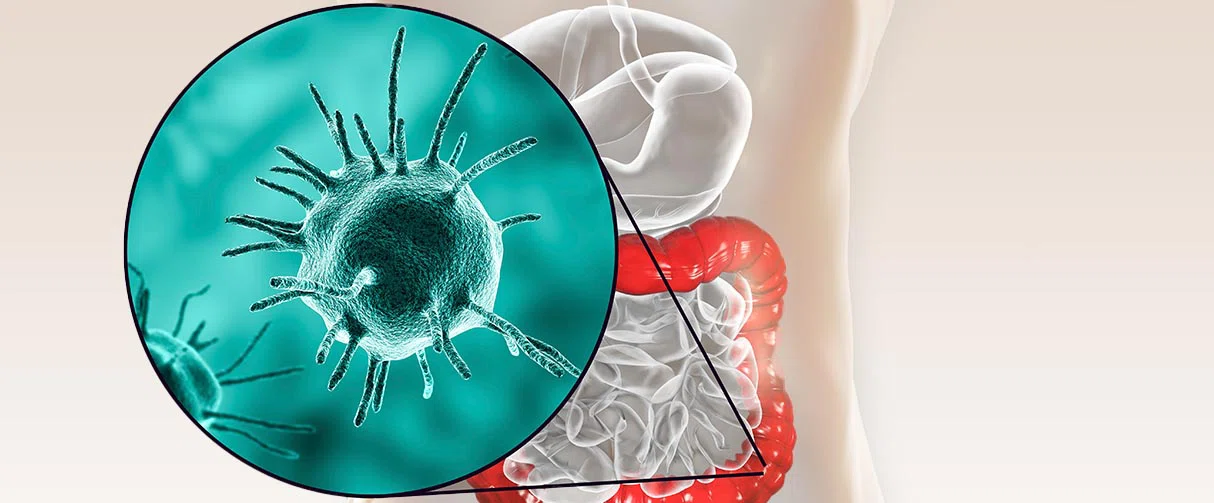


RNA helicases – which are found in all species – are a family of highly conserved enzymes that are involved in various aspects of RNA metabolism. Interestingly, RNA helicases also function as viral RNA sensors and immune signaling adaptors playing critical roles in immune responses against viruses. There is a plethora of in vitro studies regarding functions of RNA helicases in immune responses; but a paucity of in vivo studies detailing their tissue or cell specific functions and mechanisms of action. This is largely due to the fact that global knockout of RNA helicases is lethal.
The intestinal tract harbors diverse microbiota. While commensal microorganisms promote health in the human host, myriad enteric pathogens (which include enteric viruses) pose a serious threat since they can cause acute and chronic diseases. The intestinal epithelial cells that line the intestinal tract carry various DNA and RNA virus sensors which detect invading enteric viruses.
The host innate immune system acts as the first line of defense against viral infections by detecting viral components such as viral DNA and RNA. So far, several DNA as well as RNA virus sensors have been identified which can activate inflammasomes – cytosolic multiprotein oligomers crucial for host defenses against viruses. One interesting member of the RNA helicase family is the DEAH-box helicase 15 (DHX15) which senses both single stranded and double stranded RNA viruses in vitro.
To add value to this area of research, Zhiqiang Zhang, PhD, associate professor at the Houston Methodist Transplant Immunology in Surgery, generated intestinal epithelial cell specific DHX15 knockout mice to investigate DHX15 function in vivo.
Using short hairpin RNA knockdown in human cells, Zhang demonstrated that DHX15 is required for intestinal inflammation induced by enteric viruses in vitro. On a mechanistic level, Zhang revealed an important functional role of DHX15 in the assembly and activation of the nucleotide-binding oligomerization domain (NOD)- like receptor family pyrin-domain-containing 6 (NLRP6) inflammasome in the intestinal epithelial cells – which leads to secretion of the cytokine IL-18.

Zhiqiang Zhang, PhD
Associate Professor of Transplant Immunology in Surgery at Houston Methodist
Zhang specifically examined the in vivo functional role of DHX15 in intestinal antiviral response and enteric virus-induced intestinal inflammation and discovered that DHX15 induces production of interferon-β (IFN-β), IFN-λ3 and IL-18 in the intestinal epithelial cells. Notably, reduced production of IFN-β, IFN-λ3 and IL-18 in the intestinal epithelial cells caused the enhanced intestinal inflammation observed in intestinal epithelial cell specific DHX15 deficient mice. Zhang concluded that DHX15 is required for controlling RNA-virus induced intestinal inflammation in vivo.
In response to double stranded RNA polyinosinic-polycytidylic acid or poly I:C (synthetic analog of double stranded RNA) and enteric RNA viruses such as rotavirus and reovirus, DHX15 is essential to produce IFN-β, IFN-λ3 and IL-18 in both human and mouse intestinal epithelial cells in vitro.
Several intestinal diseases including the intestinal bowel disease entail intestinal inflammation which is affected by diet, genetics, immunity as well as microbial factors. The role of enteric viruses in intestinal inflammation and intestinal bowel disease is not fully understood and needs to be further investigated. The human intestine is estimated to contain at least 108-1010 virus-like particles per gram; with different enteric viruses likely having varying affinities towards the gut. Research results by Zhang on DHX15, published in Cell Reports in 2021, sheds some light on how enteric viruses influence health and disease. It is likely that efforts will be made soon to develop potential therapeutics targeting DHX15 to alleviate intestinal inflammation.

Severe acute respiratory syndrome-coronavirus-2 (SARS-CoV-2) is an RNA virus that causes the ongoing coronavirus disease 2019 (COVID-19) pandemic. Gastrointestinal symptoms and fecal shedding of SARS-CoV-2 RNA are frequently observed in COVID-19 patients, and SARS-CoV-2 could efficiently infect human intestinal epithelial cells. Thus, our findings on DHX15 in controlling enteric RNA virus-induced intestinal inflammation may provide potential therapeutic applications involving targeting RNA helicase DHX15 to control SARS-CoV-2 and the intestinal inflammation induced by SARS-CoV-2.

Zhiqiang Zhang, PhD
Associate Professor of Transplant Immunology in Surgery at Houston Methodist
Interestingly, the causative virus for the COVID-19 pandemic – SARS-CoV-2 – is an RNA virus which possibly induces intestinal inflammation since the SARS-CoV-2 receptor (angiotensin-converting enzyme 2) is widely expressed in the human intestine. Furthermore, studies have demonstrated fecal samples of COVID-19 patients to be SARS-CoV-2 positive. It is quite likely that SARS-CoV-2 infects the human body via the intestinal tract like enteric viruses in addition to the respiratory route.
“Severe acute respiratory syndrome-coronavirus-2 (SARS-CoV-2) is an RNA virus that causes the ongoing coronavirus disease 2019 (COVID-19) pandemic. Gastrointestinal symptoms and fecal shedding of SARS-CoV-2 RNA are frequently observed in COVID-19 patients, and SARS-CoV-2 could efficiently infect human intestinal epithelial cells. Thus, our findings on DHX15 in controlling enteric RNA virus-induced intestinal inflammation may provide potential therapeutic applications involving targeting RNA helicase DHX15 to control SARS-CoV-2 and the intestinal inflammation induced by SARS-CoV-2,” said Zhang.
The current understanding in the literature of the enteric gut virome is rudimentary. How enteric viruses affect intestinal homeostasis and their effects on inflammation and intestinal diseases needs to be systematically investigated. Future studies on other RNA helicases, including DEAH-box helicases, especially intestinal epithelial cell specific knockdown may shed more light on these important signaling cascades and lead to potentially useful therapeutics.
Junji Xing, Xiaojing Zhou, Mingli Fang, Evan Zhang, Laurie J Minze, Zhiqiang Zhang. DHX15 is required to control RNA virus-induced intestinal inflammation. Cell Rep. 2021 Jun 22;35(12):109205. doi: 10.1016/j.celrep.2021.109205.
Abanti Chattopadhyay, PhD, April 2022
Related Articles









